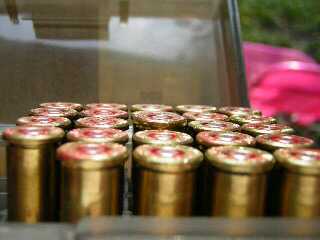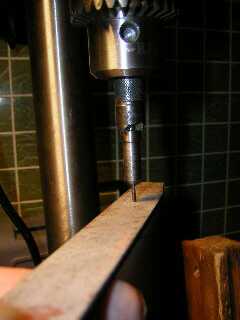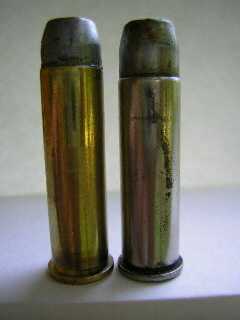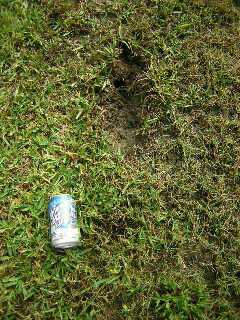|
I store my powder, primers, and seldom used ammo in a frost-free refrigerator. They stay at a constant 36 or 20 degrees and in a low humidity environment. When hunting season 2006-2007 closed I put my Rossi's 357 mag deer & hog loads in an ammo box and put it in the refrigerator. If you read Page 3 like I told you to do, you know the load is a cast 190 gr bullet pushed by a compressed charge of 16.0 grs of Lil'Gun for an AV of 1732 fps. You also know how much h-e-double-L I had getting that bullet to feed perfectly because of its large 78% meplat. I had to reduce the COAL to 1.550" and crimp it on the ogive.
 Getting ready for hunting season 2007-2008, I removed the box of loaded rounds from the refrigerator where it had rested for eight months. I let it slowly come to room temperature, then opened it. The sight on the right greeted me. (The red is fingernail polish primer sealant.)
Getting ready for hunting season 2007-2008, I removed the box of loaded rounds from the refrigerator where it had rested for eight months. I let it slowly come to room temperature, then opened it. The sight on the right greeted me. (The red is fingernail polish primer sealant.)
The round in the center sticks up above its brethren. The compressed load had pushed the bullet out of its crimp. The ogive crimp from a Lee Factory Crimp Die wasn't as strong as I had assumed. Knowing about the feeding problem from Page 3, that round would have jammed had I tried to feed it through the Rossi's action.
The thought was scary. Suppose I levered that round while a gut-shot wild boar was charging me? My ass was grass, and the boar was a lawnmower. Maybe I could say, Wait a minute Mr Boar Hog while I dig this jammed round out of my rifle.
This is why I won't shoot a wild hog unless there's a nearby climbable tree. Nearby as in I'm leaning against it. So to lessen the possibility of having to climb a tree (again), I needed to:
- Trim the cases so they would crimp in the bullet's crimp groove at a COAL of 1.550".
- Lower the charge weight; thereby lowering the compression and the un-seating force on the base of the bullet.
First, I scrounged a box of fifty nickel plated 357 cases. Using nickel cases for my shortened, high energy deer & hog load rounds, I could easily keep them separated from my brass, lower energy beer can & bad guy rounds. My concerns were (a) possible higher pressure from a different case, different crimp, and different neck tension; and (b) possible lower velocity for the same reasons plus less powder. I wanted at least 1700 fps. I expected a little carbon build up in the chamber due to the shorter cases, but I figured a brass brush would take care of that when deer & hog season ended—time to go back to the beer can & bad guy cases.
 Second, I ordered a Lee 357 mag case length gauge. When it arrived, I screwed it in a Lee cutter, then chucked the cutter in my drill press as shown. The simple application of a file to the tip of the turning case length gauge shortened it quickly—almost too quickly as the tip wasn't hardened. Go slowly if you try this.
Second, I ordered a Lee 357 mag case length gauge. When it arrived, I screwed it in a Lee cutter, then chucked the cutter in my drill press as shown. The simple application of a file to the tip of the turning case length gauge shortened it quickly—almost too quickly as the tip wasn't hardened. Go slowly if you try this.
Finally, by trial and error the original case length of 1.290" was reduced to 1.224" and the case neck centered the bullet's crimping groove when the COAL read 1.550".
I had shortened the case by .066". It was then about 1/2 way between the length of a 357 case and a 38 special case.
CASE LENGTH
- 357 = 1.290"
- mine = 1.224"
- 38 = 1.155"
I decided on a powder charge of 15.5 grs of Lil'Gun. It gave slight compression and 1717 fps in the longer cases. With a little luck I might reach my goal of at least 1700 fps.
 I loaded three rounds for running over my Chrony. I like to put my Chrony low to the ground in my front yard. I can stand on my elevated front porch and fire the rifle in a downward direction.
I loaded three rounds for running over my Chrony. I like to put my Chrony low to the ground in my front yard. I can stand on my elevated front porch and fire the rifle in a downward direction.
That's one of the three bullets on the far right beside an old one in a standard 357 case. They look to have different COALs but don't.
It rained for two solid days. On the third day the rain turned to a light sprinkle, so I set up the Chrony in my front yard. An overcast sky might give me error readings, I knew, but I dearly wanted to know the velocities of these jury-rigged rounds.
A 22 rimfire screen-checker round gave a velocity reading, so my hopes were high. I reset the Chrony and fired jury-rigged round #1—the Chrony screen said error.
I fired round #2 anyway—1752 fps. I fired round #3—1758 fps. Wow. An AV of 1755 fps, more than hoped for. The three cases showed no pressure signs. And all three rounds fed like lubed with snot, and all three extracted easily.
 I really liked the hole round #1 made in the wet ground. The angle of incidence for it and all the others was about 45 degrees. Rounds #2 and #3 hit the back of the hole, so all of the cavity was caused by the first round. I really liked the hole round #1 made in the wet ground. The angle of incidence for it and all the others was about 45 degrees. Rounds #2 and #3 hit the back of the hole, so all of the cavity was caused by the first round.
Here we see it the next day after more rain caved in the sides. It's about 8" wide, 8" deep at the rear, and 16" long. I could have buried a football in the cavity. I later tried digging for one of the three bullets, but gave up when I realized I was making a big hole in my front yard. Those three bullets went through more than two feet of wet dirt and may still be going for all I know. I won't worry about bullet penetration on ol' mossy horns.
Evidently that 78% meplat creates a heck of a shock wave. The size of the hole blown in my front yard surprised me. During past Chrony tests I fired high velocity jacketed rounds into the same ground and at the same angle of incidence, and they didn't make impact craters half that big.
Look a few inches to the right of the beer can put there for scale. You'll see a dirt disturbance caused by the impact of the 22 rimfire screen-checker round. I might could bury a marble in it.
The 190 gr group buy bullet looks like a surefire deer and hog killer. Stay tuned for the results.
|